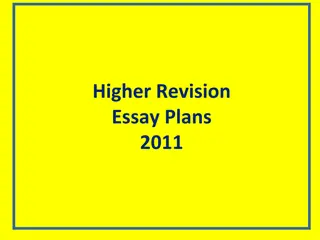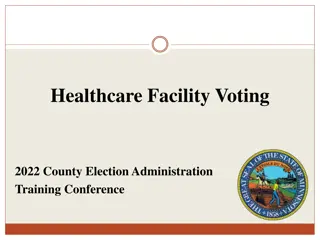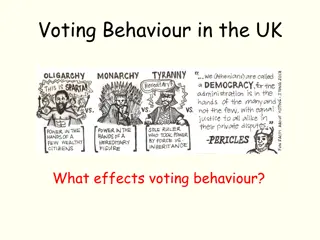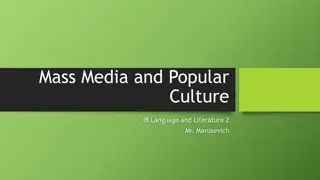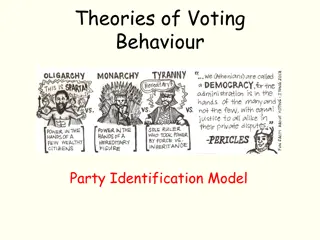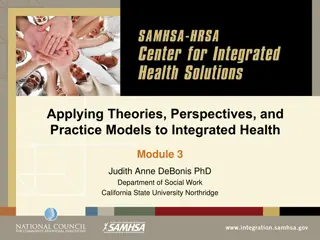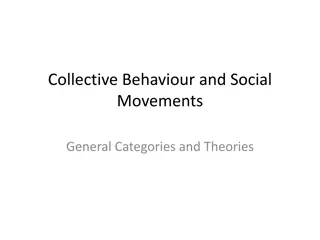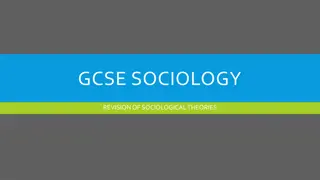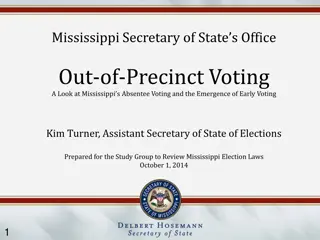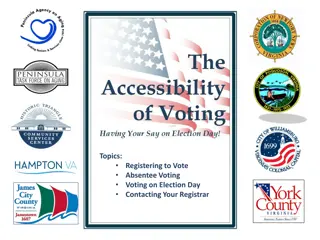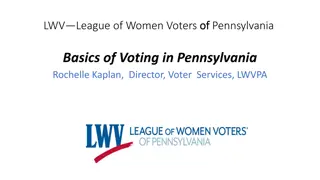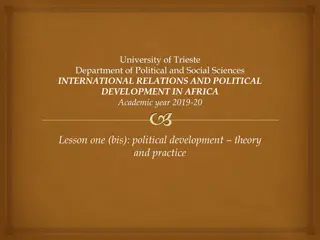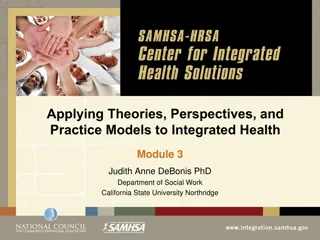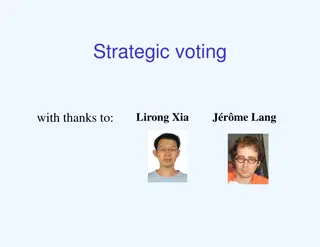Theories of Voting Behaviour and Sociological Models in Political Science
The analysis of voting behavior, also known as "psephology," delves into long-term influences like class and party loyalty, contrasting with more short-term factors such as political issues and media impact. While the Sociological Model focuses on class and party loyalties, there is a discrepancy between the ideal of informed voters and the reality of limited public involvement and understanding of party policies.
Download Presentation

Please find below an Image/Link to download the presentation.
The content on the website is provided AS IS for your information and personal use only. It may not be sold, licensed, or shared on other websites without obtaining consent from the author. Download presentation by click this link. If you encounter any issues during the download, it is possible that the publisher has removed the file from their server.
E N D
Presentation Transcript
Theories of Voting Behaviour Image result for athenian voting Sociological Model
Success Criteria I can Describe different methods used by political parties during election campaigns. Explain why some strategies are more effective than others. What you will learn How to construct answers for essay questions on media strategies.
Theories of Voting Behaviour The analysis of voting behaviour is known also as "psephology" deriving from the Greek "psephos" [a pebble] with which the ancient Athenians indicated their voting decisions. Psephologists in the UK distinguish between the period of 1945-1970 which they characterise as the era of electoral stability, two party dominance, party identification and class alignment and the period from 1970 to the present day which is described as the era of declining party identification/partisan dealignment and class dealignment. Image result for athenian voting
Thatcher 1945-1970 Two Party Class Voting 1970-present - Dealignment
Changes over time From 1970 until the present day there has been a move away from long term influences of voting behaviour such as class and party identity towards more short term influences such as political issues, the image of the party leader and the impact of the media.
Long Term Influences Psephologists have put forward competing theories/models of voting behaviour to explain why people vote the way they do. One such model is the Sociological Model of voting behaviour. This model focuses on the long term influences of class and party loyalties.
Informed Voters? An essential element of the British political party model of government is that parties aim to win office by competing for the vote of the electorate on the basis of a programme of policies. It is then argued that individual voters are rational and informed, they have an appreciation of their own best interests and so vote accordingly.
Apparently not. The electorate has not matched this model of active and informed public involvement in politics. Studies revealed just how limitedthe information that voters had concerning the policy position of the parties was Studies also highlighted the public often supported a party in spite of its policies, instead of because of them.
In a landmark text - Political Change in Britain, Butler & Stokes (1963), challenged the idea of an informed electorate. They argued that the behaviour of the electorate is shaped less by particular issues than it was by generalised attitudes and beliefs about party image. Image result for labour Image result for conservative
Class Social class is a measure of a person s status or position within society. For example, social class usually takes account of an individual s income, wealth, occupation, education, etc, although different classifications use different criteria. It is this idea of a party image that was taken by most commentators of the time as evidence that Britain, at least until the late 1970s, was the purist example of class voting in any Western industrial democracy.
Quote to use! Pulzer (1967), claimed: 'Class is the basis of British party politics; all else is embellishment and detail.' Discuss how important a role social class plays in society and politics in the UK today
How does Social Class affect Voting behaviour? Traditionally then, psephologists have identified social class as the most important factor associated with voting behaviour. This is hardly surprising given that one of the major political parties - Labour - was founded upon a commitment to a class, and whose origins lie in the organised trade union movement and socialism.
The Sociological Model This sociological model of voting behaviour, associated with Butler and Stokes, was based on the consistent finding that social class was the most accurate indicator of likely voting intention. In general, working class voters did vote for the Labour Party, and middle class voters voted Conservative. Usually, about two-thirds of the working class voted Labour, while four-fifths of the middle class voted Conservative.
The Sociological Model In the period 1945-70, it was assumed that stable two party voting was the norm. During this period the following situation prevailed:
The Sociological Model Two party dominance -The overwhelming majority of the electorate voted Conservative or Labour. Partisan alignment - Most people identify with the party for which they vote. Party membership high compared with other countries. The majority supported the policies of the party for which they vote. Electoral volatility was low - few people changed their vote between elections.
The Sociological Model Therefore psephologists were confident that the sociological model could explain why people voted the way they did from 1945 until 1970. Class alignment was high, i.e. there was a long term association of a social class with support for a particular party.
The Sociological Model However during the last 40 years psephologists have become wary of using this model to explain voting behaviour. This is due to a steady decline in class voting, called class de- alignment. No longer could analysts explain to the same extent why people voted the way they did. Voters have started to vote based on a variety factors not just social class. Some would argue that this rends the Sociological Model illegitimate Nevertheless it is important remember that Labour still remains the most popular party among working class voters and the Conservatives the most popular party among the middle class.
Question Task 1. 2. Did Butler and Stokes believe in an informed electorate ? Explain your answer. 3. Explain in your own words what you think the Pulzer quote means? 4. Describe the Sociological Model of voting behaviour. 5. Define the terms class alignment and class dealignment. 6. Read the article your teacher will give you and take examples about the relevance of the Sociological model today. What is psephology the study of?
Analyse the relevance of the Sociological Model in explaining voting behaviour (12) Credit reference to the following aspects of the question: The role of social class in influencing voting behaviour. Factors leading to class de-alignment. Other socio-economic factors such as age, gender, region.
Analyse the relevance of the Sociological Model in explaining voting behaviour (12) The Sociological Model is based on the idea that voters would favour a party based on their social groupings, for example this could be their Social Class, with middle class people more likely to vote for the Conservatives and the working classes more likely to vote Labour. (K) There was evidence of a link between a person s social class as measured by their occupation and their party preference. A, B and C1 voters (professional and managerial occupations) traditionally supported the Conservatives and voters in occupational classes C2, D and E (manual occupations) were much more likely to support Labour. (K) For example, in the period from the Second World War up to the 1970 s this appeared to be the case. In the 1950 s and 1960 s, most voters could be categorised as middle class Conservatives or working class Labour supporters with high levels of absolute class voting. (KE) In these years, Labour and the Conservatives between them often accounted for over 95% of total votes cast. The significance of class led Pulzer to state that social class was the basis of party politics, everything else was just embellishment and detail . (KE)
Paragraph 2 Factors leading to class de-alignment - Class de-alignment has occurred alongside a decline in partisan alignment; public are more interested in single issues and do not necessarily identify with a party as a whole. - Iraq War lost Labour Ethnic Minority votes even though the majority of ethnic minority Brits are considered class C2/D/E etc
Paragraph 3 Socio-economic factors Can all factors be linked to social class? Choose two other long-term factors and highlight how they may still hold a sociological relevance/do not hold a sociological relevance.
Analyse the relevance of the Sociological Model in explaining voting behaviour (12) However, it is clear to see that the Sociological Model no longer holds the relevance that it did in previous years. The support for the two main parties has declined from over 95% in the 1950 s to around 65% in 2010. There has been an increase in support for smaller parties who attract voters across all classes. (A) During this period the number of A, B and C1 voters supporting the Conservatives has fallen below 50% and in 1997 Labour actually achieved a higher level of support in the C1 category than the Conservatives did. The number of C2, D and E voters supporting Labour has also declined. (A)
Image result for athenian voting Image result for athenian voting Image result for voting








